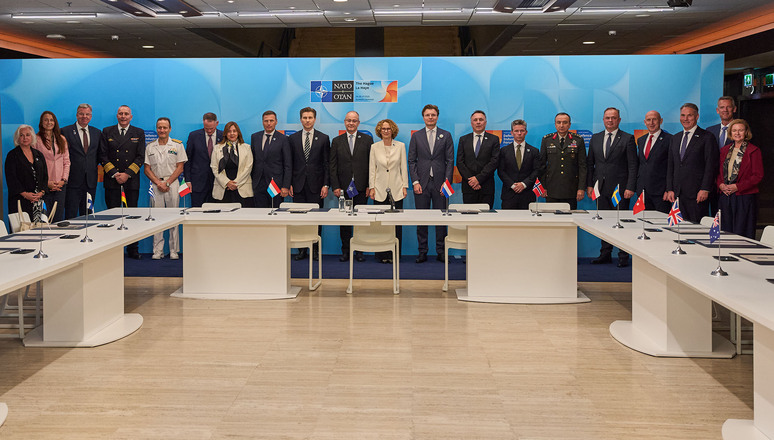Highlights:
- NATO Allies sign major industrial deals, including joint raw material stockpiling and new technology test zones.
- Denmark and Sweden join NATO’s Multi Role Tanker Transport Fleet; two new MRTT aircraft ordered from Airbus.
- NATO leaders expected to endorse a 5% GDP defense spending goal by 2035; Spain and the U.S. reject binding commitment.
- Australia signs partnership agreement with NSPO to join NATO logistics, procurement, and operational networks.
- Summit convenes under tight security amid Iran strike fallout and broader Israel-Iran tensions.
NATO opened its 2025 summit Tuesday under heightened security as leaders signed groundbreaking multinational defense industry agreements, endorsed sweeping innovation initiatives, and confronted geopolitical tensions stemming from the recent U.S. strike on Iran’s nuclear facilities.
High Visibility Project: Raw Materials Security
In a major development at the NATO Defence Industry Forum, twelve member nations — Belgium, Canada, Denmark, Germany, Greece, Italy, the Netherlands, Norway, Poland, Sweden, Türkiye, and the United Kingdom — committed to jointly acquire, store, transport, and manage stockpiles of defense-critical raw materials.
This “High Visibility Project” will support access to materials such as lithium, titanium, and rare earth elements, which are essential for modern weapons systems and defense manufacturing. NATO said the effort will help the Alliance reduce reliance on external providers and protect supply chains against shocks, as part of its Defence Critical Supply Chain Security Roadmap.
Air Power and Innovation Milestones
The Multinational Multi Role Tanker Transport Fleet (MMF) expanded as Denmark and Sweden formally joined the initiative. NATO’s procurement agency signed a contract with Airbus Defence and Space for two more A330 MRTT aircraft, raising the fleet to 12 planes.
Meanwhile, Estonia, Finland, Italy, Latvia, the Netherlands, and Sweden announced the establishment of the first NATO Innovation Ranges. These test environments are intended to accelerate the adoption of new military technologies and integrate non-traditional suppliers into NATO’s defense production ecosystem. The program is a key pillar of NATO’s Rapid Adoption Action Plan, expected to be endorsed at the summit.
Australia Joins NATO Procurement Network
In another significant move, Australia signed a partnership agreement with the NATO Support and Procurement Organisation (NSPO), granting it access to NATO’s full range of logistical, acquisition, and systems support services. NATO Deputy Secretary General Radmila Shekerinska said the deal represents a “milestone” in NATO’s global partnerships.
5% GDP Defense Spending Goal Sparks Debate
Perhaps the most controversial item on the summit agenda is NATO’s new proposed defense spending target: 5% of GDP by 2035. The goal includes 3.5% for direct military expenditures and 1.5% for broader infrastructure and innovation investment.
While many Eastern European countries support the increase, divisions emerged. According to AP News, Spain secured an exemption, agreeing to maintain spending at 2.1% of GDP. President Donald Trump told reporters the target “shouldn’t apply to the U.S.” but urged other allies to “meet their fair share.”
Trump reportedly considered skipping the summit to pressure allies but ultimately attended amid growing scrutiny of U.S. commitment to NATO’s long-term goals.
Security and Geopolitical Tensions
This year’s summit unfolds amid high tensions following the U.S. airstrike on Iran’s nuclear sites. The Dutch government deployed F-35 fighter jets, Patriot missile batteries, and counter-drone measures around the venue.
Some NATO members pushed for urgent diplomatic engagement with Iran and called for de-escalation in the broader Iran-Israel conflict, although Iran was not formally on the summit agenda.
Reduced Focus on Ukraine and Indo-Pacific
Compared to last year’s high-profile Washington summit, this year’s event is notably scaled down. Ukraine-related discussions were deprioritized, and the NATO-Ukraine Council leaders’ meeting — a centerpiece of last year’s agenda — was removed. NATO’s Indo-Pacific engagements were also reduced to closed-door bilateral talks.
Sources and Citations
- NATO: Defence Industry Forum, The Hague – 24 June 2025
- AP News: NATO members debate 5% defense spending target
(with reporting from NATO ande AP News)
A global media for the latest news, entertainment, music fashion, and more.















